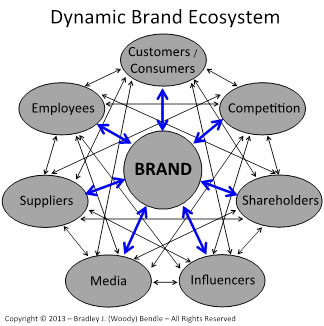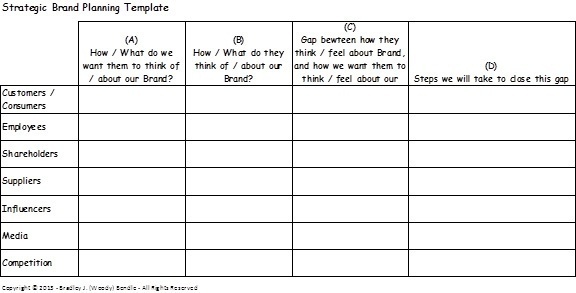Customer experience strategy and innovation expert Woody Bendle is sharing his perspective on the links between corporate strategic planning and brand strategy today, including a great strategic brand planning tool to help identify branding opportunities and gaps your organization faces. Without delay, here's Woody!
Brand Strategy - A Strategic Brand Planning Tool by Woody Bendle
Mike has published recent pieces on strategy and strategic planning that inspired me to reflect on the process and effectiveness of strategy, especially brand strategy. It fascinates me that strategy and strategic planning are often considered separate and different from brand strategy. Since many executives don’t understand what a brand is, they don’t realize an organization’s brand should govern and be the basis for corporate strategy and planning.
Strategy and Brands
Strategy should effectively set an organization apart from competitors. A good strategy (well executed) can make an entity appreciably unique and compellingly relevant to a meaningful proportion of consumers. This is precisely what a good brand does! So why is brand strategy so often overlooked in corporate strategy or planning?
I believe there are three reasons:
- Lack of understanding
- Misperceptions - Corporate strategy and planning are considered to be for “left-brained numbers people’ and brand strategy (if an organization even does it) is for “right-brained marketing
- Complexity - Brands are complex, somewhat abstract, and don’t fit neatly into financial spreadsheets
While the concept of a brand can be difficult to get your head around, that complexity shouldn’t suggest branding be ignored. Let’s break down the concept to its component parts, tackling the basic definition first.
So what is a Brand?
Most of us can name dozens of brands, including our “favorite” brands. We can describe brands and frequently make decisions because of them. So, while brands play roles in our lives, defining a brand is where many get hung up.
Through studying how consumers and organizations develop, manage, think about and relate to brands, I’ve developed the following definition:
A Brand is something that provides and is both identity and meaning. It is a continual interpretation that exists as a result of that which is conveyed by an entity through its communications, products and/or services, and that which is understood by those who interact with that entity’s communications, products and/or services.
That seems pretty abstract and complex, I’ll admit. Let’s simplify it to an organization’s brand being:
- Who it is
- What it stands for or represents
- Why it exists
- How it behaves, communicates, and/or operates
- How it is, and how it wants to be seen and/or thought of
For those interacting with (i.e., purchasing, using, consuming) a brand, it is:
- A commitment or promise by or from the brand itself
- An aid for decision making
- An intrinsic and extrinsic reflection of who they are
- A statement about what they value and believe in
- A tacit or explicit signal about how they see themselves and how they want to be seen by others
The next layer of complexity in branding is because brands are not completely within an organization’s control. While companies or individuals create brands, they exist in a dynamic perceptual ecosystem, i.e. an intricate network of interactions between and among an array of constituents (as shown here).
Brands directly interact with and influence perceptions for a number of different constituents (the blue arrows). These constituents influence and affect the brand through reciprocal relationships of varying strength. Over time, the full power and impact of a brand results from a vast multitude of direct and indirect interactions within the ecosystem.
This creates two implications:
- Once a brand is launched, the originator no longer fully owns it. It is shared by all who directly and / or indirectly interact with it.
- While the brand’s originator does not fully own the brand, it retains absolute responsibility today and in the future for how the brand is viewed.
So because brands are complex and are shaped by others outside your organization, managing it overall demands a well-articulated brand strategy!
A Strategic Brand Planning Tool
So with the definition addressed, let’s pull apart a brand and systematically examine all the different brand interactions. This tool I developed helps me effectively do that:
Step one is identifying the brand constituents populating the rows by answering:
- Who are all the parties interacting with your brand?
- Who has a say in your brand’s future?
After creating your own list of brand constituents systematically work through each column.
- Column A - Think about how you would like each constituent group to describe your Brand. What should your brand stand for with each of them? How should it be known? Note - this is an internal exercise since you have to answer and own how and what you want others to think about your brand.
- Column B – How does each of these different groups actually think about, or describe your brand? What are they saying about it to others? Are you regarded positively by some and negatively by others? Surveys and social media listening are great sources for this.
- Column C – This column pinpoints areas with differences between how you want your brand to be thought of and how it is currently regarded. Some differences will be subtle and others could be rather large. Additionally, this column’s answer can be quantitative and/or qualitative.
- Column D – After identifying areas with meaningful perception differences, outline things your organization can or will do to close these perception or image gaps.
As you work through brand tool, some cells will be easier than others to complete. Only you can determine whether it is worth the effort to collect the information needed. After using this tool many times, I’m confident you will identify several things important to your brand’s future that warrant further discussion and attention.
Good (Company) to Great (Brand)
 Companies and organizations are a dime-a-dozen; many have very similar overarching goals and objectives. If an organization has been around for any length of time, it is probably doing a number of things well. But is it truly great? Is it considered a Great Brand?
Companies and organizations are a dime-a-dozen; many have very similar overarching goals and objectives. If an organization has been around for any length of time, it is probably doing a number of things well. But is it truly great? Is it considered a Great Brand?
Great Brands are different; they are one-in-a-million! Great Brands connect by providing a deeper sense of identity and meaning. Great Brands wind up tattooed on peoples bodies (I’m betting the first brand that came to you right now was Harley Davidson)!
Great Brands don’t happen by accident! Great Brands are the result of great, well-executed brand strategies!
As you tune your strategic plans for next year, secure a seat at the strategic planning table for your brand management effort. It just might earn your brand a prominent place on someone’s body! - Woody Bendle





